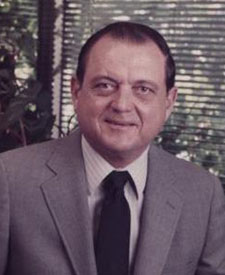George F. Hutton
Go to Oral HistoryReturn to Biographies & Oral Histories Home

One of the dozen or so men who left Peter Kiewit Sons’ with Charlie Pankow when the latter started Charles Pankow, Inc., in 1963, George Hutton established and developed the company’s Honolulu-based subsidiary into one of the largest contractors in Hawaii. He also became one of the three largest shareholders in the company at the time of the company’s reorganization, in 1986.
Born in Osceola, Missouri, in 1932, Hutton graduated from the University of Missouri in 1954 with a degree in civil engineering. He worked briefly for Standard Oil Company’s construction department at its Whiting, Indiana, refinery before he was inducted into the military, in February 1955.
Hutton served two years in the U.S. Army Corps of Engineers and the Military Intelligence Group. He returned to Standard Oil after his discharge from the army, but his desire to work directly for a contractor persuaded him to leave Standard Oil in the summer of 1957. He took a job with Joliet, Illinois-based Graver Construction Company and was assigned as the project engineer to complete a chemical and paint factory in Chicago Heights. When that project ended in August, 1958, Hutton returned to Kansas City where he grew up. He found work with Frank Quinlan Construction Company, which had landed a contract to build a facility for Western Electric.
In the summer of 1960, as work continued on that project, Hutton responded to an advertisement for work with Peter Kiewit Sons’. He had thought highly of the company since his days at the University of Missouri. He interviewed for the job at the company’s main offices in Omaha, Nebraska, but Kiewit failed to win the project that had prompted the search. The personnel manager who interviewed Hutton, however, forwarded the latter’s résumé to Charlie Pankow, who, in October 1960, invited Hutton to interview in Los Angeles. Hutton agreed. Pankow promptly hired Hutton as a field engineer and assigned him to the El Cortez Convention Center project in San Diego, which Alan Murk was supervising.
In three years with Kiewit’s Arcadia, California-based building division, Hutton helped to build four other projects in San Diego: the First and C Building (a downtown office tower), Hillcrest North Medical Center, the Circle Arts Theater, and the Rancho Bernardo Reservoir.
While he was working at the latter project, Charlie Pankow left Kiewit with several of his colleagues to start his own firm. Pankow soon invited Hutton to join the new company. Hutton, who by this time had developed a great respect for Charlie Pankow’s design-build approach to construction, jumped at the chance.
From 1963 to 1965, Hutton worked on the construction of MacArthur Broadway Center in Oakland, California. At the end of the project, Charlie Pankow sent him to Honolulu to oversee the construction of the James Campbell Building for the James Campbell Estate. The project had developed out of Pankow’s relationship with Y. C. Yang and Felix Kukla, the structural engineers on MacArthur Broadway Center, and their connections to Leo S. Wou, the architect of the James Campbell Building.
Hutton faced many challenges in completing the project. At its end, Charlie Pankow left Hutton in Hawaii to see if he could develop additional work.
Over the next two decades, Hutton built Charles Pankow Associates (CPA), the company’s Hawaii subsidiary, into a leading local contractor. During Hutton’s tenure, CPA completed almost four dozen projects. They include some of the most distinctive towers that frame the Honolulu skyline, such as Century Center, Executive Centre, and Honolulu Park Place. In many of these efforts, Hutton acted as a merchant builder, taking a development interest in order to salvage projects that otherwise would have remained on the drawing board. George Hutton and Charlie Pankow also developed several condominium projects, which generated construction work for the company and significant returns on investment for the partners.
As Hutton describes in his interview, his relations with Charlie Pankow deteriorated rapidly after the latter engineered a reorganization, announced in September 1986, that folded CPA into a new entity, Charles Pankow Builders, Ltd. The contract for the Waikiki Landmark, a spectacular, twin-towered condominium located at the “gateway” to the Waikiki district, was the last that Hutton signed with the company. He tendered his resignation from the company in 1991.

